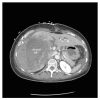Liver transplantation in the treatment of severe iatrogenic liver injuries
- PMID: 28932348
- PMCID: PMC5583534
- DOI: 10.4254/wjh.v9.i24.1022
Liver transplantation in the treatment of severe iatrogenic liver injuries
Abstract
The place of liver transplantation in the treatment of severe iatrogenic liver injuries has not yet been widely discussed in the literature. Bile duct injuries during cholecystectomy represent the leading cause of liver transplantation in this setting, while other indications after abdominal surgery are less common. Urgent liver transplantation for the treatment of severe iatrogenic liver injury may-represent a surgical challenge requiring technically difficult and time consuming procedures. A debate is ongoing on the need for centralization of complex surgery in tertiary referral centers. The early referral of patients with severe iatrogenic liver injuries to a tertiary center with experienced hepato-pancreato-biliary and transplant surgery has emerged as the best treatment of care. Despite widespread interest in the use of liver transplantation as a treatment option for severe iatrogenic injuries, reported experiences indicate few liver transplants are performed. This review analyzes the literature on liver transplantation after hepatic injury and discusses our own experience along with surgical advances and future prospects in this uncommon transplant setting.
Keywords: Acute liver failure; Biliary injury; Iatrogenic liver injury; Liver transplantation; Surgical complication; Tertiary referral center; Urgent liver transplantation; Vascular injury.
Conflict of interest statement
Conflict-of-interest statement: No conflict of interest to declare.
Figures



Similar articles
-
From Laparoscopic Cholecystectomy to Liver Transplantation: When the Gallbladder Becomes the Pandora s Box.Chirurgia (Bucur). 2016 Sept-Oct;111(5):450-454. doi: 10.21614/chirurgia.111.5.450. Chirurgia (Bucur). 2016. PMID: 27819646
-
Liver transplantation for iatrogenic bile duct injuries sustained during cholecystectomy.Hepatol Int. 2013 Jul;7(3):910-5. doi: 10.1007/s12072-013-9442-3. Epub 2013 Jul 31. Hepatol Int. 2013. PMID: 26201929
-
Iatrogenic bile duct injury: the scourge of laparoscopic cholecystectomy.ANZ J Surg. 2002 Feb;72(2):83-8. doi: 10.1046/j.1445-2197.2002.02315.x. ANZ J Surg. 2002. PMID: 12074081
-
Difficult iatrogenic bile duct injuries following different types of upper abdominal surgery: report of three cases and review of literature.BMC Surg. 2019 Nov 6;19(1):162. doi: 10.1186/s12893-019-0619-0. BMC Surg. 2019. PMID: 31694627 Free PMC article. Review.
-
Changing patterns of traumatic bile duct injuries: a review of forty years experience.World J Gastroenterol. 2002 Feb;8(1):5-12. doi: 10.3748/wjg.v8.i1.5. World J Gastroenterol. 2002. PMID: 11833062 Free PMC article. Review.
Cited by
-
Platelet-rich fibrin can accelerate the healing of common bile duct anastomosis in a rat.Turk J Surg. 2020 Sep 28;36(3):256-263. doi: 10.47717/turkjsurg.2020.4564. eCollection 2020 Sep. Turk J Surg. 2020. PMID: 33778380 Free PMC article.
-
Liver transplantation for iatrogenic injuries secondary to cholecystectomy: a systematic review.Int J Surg. 2023 Jul 1;109(7):2120-2128. doi: 10.1097/JS9.0000000000000430. Int J Surg. 2023. PMID: 37288548 Free PMC article.
-
Liver transplantation for the treatment of iatrogenic bile duct injury.Rev Col Bras Cir. 2023 Jul 28;50:e20233565. doi: 10.1590/0100-6991e-20233565-en. eCollection 2023. Rev Col Bras Cir. 2023. PMID: 37531504 Free PMC article. No abstract available.
References
-
- Thomson BN, Parks RW, Madhavan KK, Garden OJ. Liver resection and transplantation in the management of iatrogenic biliary injury. World J Surg. 2007;31:2363–2369. - PubMed
-
- Lubikowski J, Chmurowicz T, Post M, Jarosz K, Białek A, Milkiewicz P, Wójcicki M. Liver transplantation as an ultimate step in the management of iatrogenic bile duct injury complicated by secondary biliary cirrhosis. Ann Transplant. 2012;17:38–44. - PubMed
Publication types
LinkOut - more resources
Full Text Sources
Other Literature Sources

